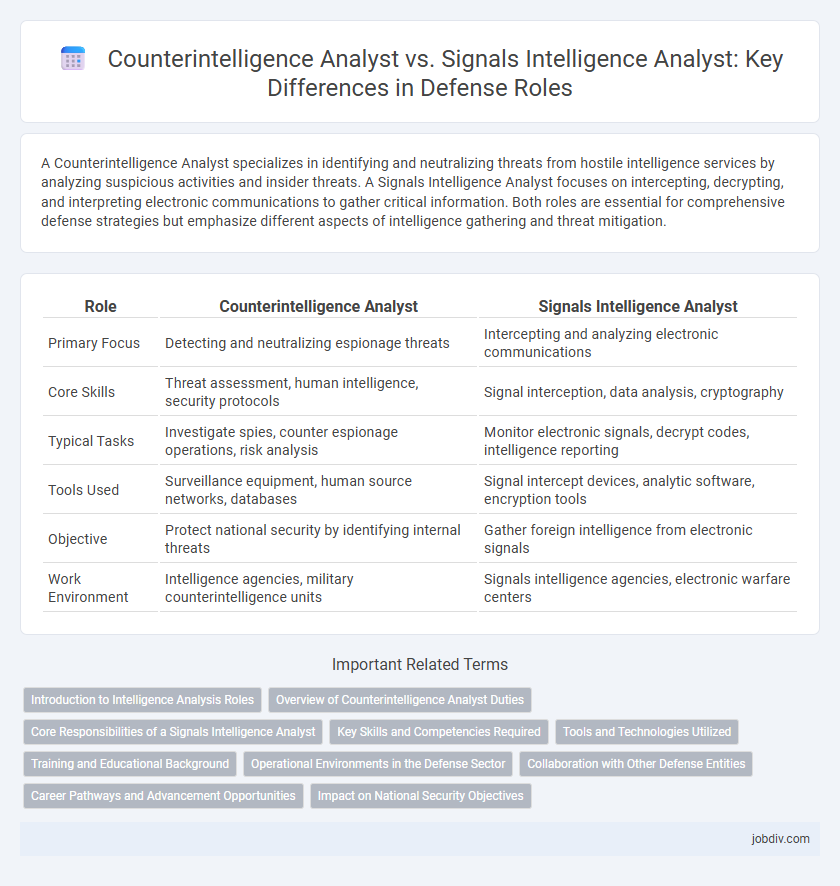A Counterintelligence Analyst specializes in identifying and neutralizing threats from hostile intelligence services by analyzing suspicious activities and insider threats. A Signals Intelligence Analyst focuses on intercepting, decrypting, and interpreting electronic communications to gather critical information. Both roles are essential for comprehensive defense strategies but emphasize different aspects of intelligence gathering and threat mitigation.
Table of Comparison
| Role | Counterintelligence Analyst | Signals Intelligence Analyst |
|---|---|---|
| Primary Focus | Detecting and neutralizing espionage threats | Intercepting and analyzing electronic communications |
| Core Skills | Threat assessment, human intelligence, security protocols | Signal interception, data analysis, cryptography |
| Typical Tasks | Investigate spies, counter espionage operations, risk analysis | Monitor electronic signals, decrypt codes, intelligence reporting |
| Tools Used | Surveillance equipment, human source networks, databases | Signal intercept devices, analytic software, encryption tools |
| Objective | Protect national security by identifying internal threats | Gather foreign intelligence from electronic signals |
| Work Environment | Intelligence agencies, military counterintelligence units | Signals intelligence agencies, electronic warfare centers |
Introduction to Intelligence Analysis Roles
Counterintelligence Analysts specialize in identifying and countering threats posed by foreign intelligence services and insider threats, focusing on protecting national security assets and sensitive information. Signals Intelligence Analysts gather, process, and interpret intercepted communications and electronic signals to provide actionable intelligence on adversaries' capabilities and intentions. Both roles are critical in the intelligence cycle, with Counterintelligence Analysts emphasizing threat prevention and Signals Intelligence Analysts concentrating on data collection and technical analysis.
Overview of Counterintelligence Analyst Duties
Counterintelligence analysts specialize in identifying and mitigating threats posed by hostile intelligence services, focusing on protecting sensitive information and countering espionage activities. Their duties include analyzing intelligence reports, conducting investigations into potential insider threats, and collaborating with security agencies to prevent breaches. Unlike signals intelligence analysts who primarily intercept and analyze electronic communications, counterintelligence analysts emphasize human intelligence and behavioral patterns to safeguard national security.
Core Responsibilities of a Signals Intelligence Analyst
Signals Intelligence Analysts specialize in intercepting, analyzing, and exploiting electronic communications and signals to provide actionable intelligence. Their core responsibilities include monitoring electromagnetic emissions, decoding encrypted messages, and identifying patterns in adversary communications to support military operations and national security. These analysts leverage advanced technology and cryptographic techniques to detect threats and contribute to strategic decision-making processes.
Key Skills and Competencies Required
Counterintelligence Analysts require strong analytical skills to identify and assess threats from foreign intelligence services, proficiency in human behavior analysis, and expertise in counter-surveillance and deception detection techniques. Signals Intelligence Analysts must possess advanced technical skills in signal interception, electronic communication systems, cryptography, and data exploitation, alongside the ability to interpret complex electronic and digital data. Both roles demand high attention to detail, critical thinking, and the ability to operate within classified environments under strict security protocols.
Tools and Technologies Utilized
Counterintelligence analysts primarily utilize HUMINT databases, advanced analytics software, and secure communication platforms to detect and prevent espionage activities. Signals intelligence analysts rely heavily on electronic surveillance tools, signal interception equipment, and cryptanalysis software to gather and decode enemy communications. Both roles depend on cutting-edge cybersecurity technologies to protect sensitive information and support strategic military operations.
Training and Educational Background
Counterintelligence analysts typically receive training in behavioral analysis, foreign languages, and counterespionage techniques, often holding degrees in criminal justice, international relations, or psychology. Signals intelligence analysts require expertise in communications technology, cryptography, and electronic surveillance, with backgrounds commonly in computer science, information technology, or electrical engineering. Both roles undergo specialized government or military training programs, but counterintelligence emphasizes human intelligence and threat assessment, while signals intelligence focuses on technical skills and data interception.
Operational Environments in the Defense Sector
Counterintelligence Analysts operate primarily in human intelligence (HUMINT) environments, focusing on identifying and neutralizing insider threats and foreign espionage within defense networks. Signals Intelligence Analysts specialize in electronic and signal interception activities within cyber and electronic warfare domains, enabling real-time threat detection and communication exploitation. Both roles are critical in integrated defense operations, with Counterintelligence Analysts emphasizing counterespionage tactics and Signals Intelligence Analysts enhancing situational awareness through signal data analysis.
Collaboration with Other Defense Entities
Counterintelligence Analysts work closely with defense agencies, military intelligence units, and law enforcement to identify and neutralize internal threats, ensuring operational security through information sharing and joint investigations. Signals Intelligence Analysts collaborate with cyber defense teams, signal intercept units, and allied intelligence services to collect and analyze electronic communications, providing real-time intelligence for tactical and strategic decision-making. Both analyst roles depend on seamless interagency communication and integrated intelligence frameworks to enhance national security efforts.
Career Pathways and Advancement Opportunities
Counterintelligence Analysts typically advance through roles involving threat assessment, operational security, and investigative analysis, often progressing into senior intelligence positions or leadership roles within national security agencies. Signals Intelligence Analysts focus on intercepting and interpreting communications data, with career growth opportunities in data analytics, cyber operations, and technical intelligence management. Both career pathways demand continuous skill development in emerging technologies and offer advancement into strategic intelligence advisory or policy-making positions.
Impact on National Security Objectives
Counterintelligence Analysts play a critical role in identifying and neutralizing insider threats and espionage activities that directly undermine national security objectives. Signals Intelligence Analysts collect, analyze, and interpret intercepted communications, providing real-time actionable intelligence to support military operations and strategic decision-making. Both specialties enhance national security by preventing adversary advantages, but their impact differs as counterintelligence focuses on threat prevention within own assets, while signals intelligence emphasizes external threat detection and battlefield awareness.
Counterintelligence Analyst vs Signals Intelligence Analyst Infographic

 jobdiv.com
jobdiv.com